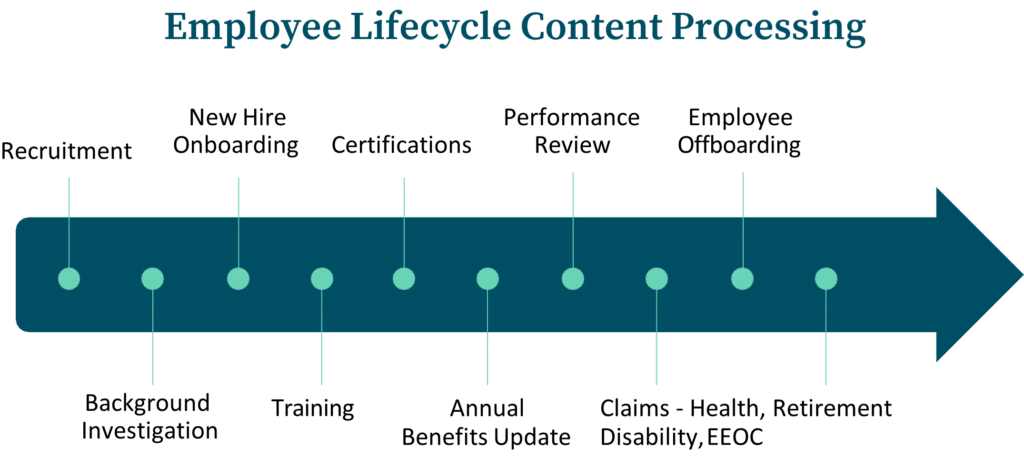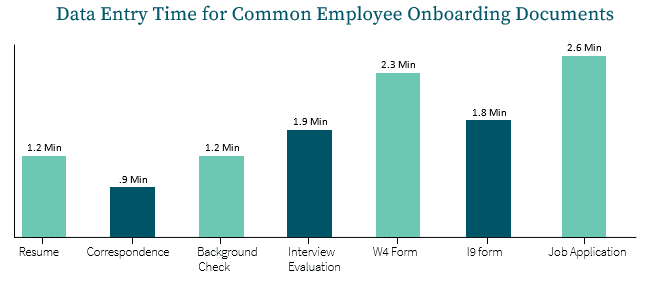
What Is Human Resources Automation?
Human resources (HR) automation uses software to streamline manual HR tasks, reducing the need for human intervention. It lets HR departments replace paper and legacy systems with a single automated solution for recruitment, onboarding, payroll, and performance management. The result is increased efficiency and accuracy. HR professionals can free themselves from grunt work and focus on more strategic tasks.

Which HR Processes Can You Automate?
Kickstart HR Automation
Ready to start automation but not sure where to begin? A good first step is to identify tasks that align with the following criteria:
“…56 percent of typical “hire-to-retire” tasks could be automated with current technologies and limited process changes.”
—McKinsey & Company

If highly skilled HR professionals in your organization are burdened with outdated paper-bound workflows and systems, you have a massive opportunity to boost efficiency with document management software.
A solution like DocStar lets you consolidate all your paper, printing, faxing, and filing into an automated single source of truth. HR professionals can prioritize attracting and nurturing your organization’s human resources over endless administration.
A robust HR automation solution like DocStar lets your HR team capture, store, and manage documents from anywhere–on any device. Whether scanning paper documents or uploading electronic files, the intelligent data capture feature transforms them into editable, shareable, and searchable formats. You can capture whole documents or extract specific fields and information.
Within the system, you can manipulate, analyze, and retrieve documents with just a few clicks. DocStar oversees content throughout the entire employee lifecycle, from recruitment to retirement, ensuring compliance with industry regulations at every step.

Critical Elements of Your HR Automation Software
Document Creation & Storage
Creating electronic documents from any source and storing them securely in a centralized repository.
Metadata & Retrieval
Attaching metadata for categorization and enabling search to quickly locate documents later.
Version Control & Collaboration
Storing multiple versions to maintain integrity and allowing users to collaborate on the “same” documents simultaneously.
Access Control & Security
Setting user permissions and implementing robust protocols, backups, and encryption to keep documents safe.
Routing & Archiving
Automating workflows between systems and users and retaining documents in line with policy before safe deletion.
Audit Trails
Recording document actions like create, access, edit, and delete to make audits less stressful and time-consuming.
“Organizations in which HR facilitates a positive employee experience are 1.3 times more likely to report organizational outperformance, McKinsey research has shown..”
—McKinsey & Company

HR automation is revolutionizing how organizations manage their workforce. By automating repetitive and time-consuming tasks like recruitment, onboarding, payroll, and performance reviews, HR teams can work more strategically. This leads to greater efficiency, fewer errors, and a more cohesive work environment.
By simplifying repetitive and laborious tasks, HR professionals can focus on strategic initiatives like employee retention.
Automated workflows guarantee consistent and accurate HR processes, eliminating the most common causes of human error.
Automation allows quick and precise responses to Labor Department requests. You can instantly retrieve and email documents, including full employee files, even during calls. Never lose any document, even irregular-sized ones like doctor’s notes.
HR automation tools actively monitor and adapt to regulatory changes, helping you stay compliant. Built-in security features maintain employee privacy in line with federal laws like HIPAA. Because documents are stored electronically, they’re safe from loss or damage.
HR process automation streamlines employee onboarding, enhances communication, and strengthens employee engagement. Eliminating tedious tasks boosts morale and improves retention rates.
Self-service features in HR tools empower employees to manage personal data, leave requests, benefits, and more. They cater to the growing expectations for personalized HR services, enhancing job satisfaction.
Automated HR processes adapt and scale as your business evolves and expands–without a corresponding increase in cost or headcount.
HR automation empowers organizations to rapidly adapt and implement new processes in response to evolving market dynamics and employee needs. It enables proactive, forward-thinking teams by removing manual bottlenecks and optimizing operations at speed.
Digitizing HR processes makes previously inaccessible data readily available. This data can inform decisions, revealing trends, bottlenecks, and areas ripe for organizational improvement.
Automated HR ensures uniform processes, from recruitment to employee performance tracking and evaluations. Consistency promotes a fair, bias-free environment, building trust within the organization.
Switching to digital processes dramatically lowers your company’s paper usage and minimizes waste. Reduced consumption signals your commitment to sustainability and keeps you ahead of shifting environmental standards.
Going paperless reduces the need for physical storage, shipping, and supplies expenses. Automation also reduces manual work, saving labor costs and avoiding expensive mistakes.

HR Automation Challenges
Some HR tasks are harder to automate. For example, change management, conflict resolution, business strategy, and training and development require high emotional intelligence and refined soft skills.
Manual, document-heavy processes, on the other hand, are easy to automate. So long as you have the right software. But as with any digital transformation, you’ll encounter challenges–ones that the right vendor will help you overcome.
Resistance to change
Employees in the HR department may be wary of automation changes, fearing job loss or new technology. Listen to their concerns, set clear timelines, and provide ample employee training. This fosters understanding and support for the transition.
Loss of the human touch
When implemented poorly, automation reduces face-to-face interactions, losing the personal touch essential in HR processes. When implemented effectively, organizations can free up time for people-oriented tasks, making employees feel more appreciated.
Security and privacy
HR software collects a vast amount of both structured and unstructured data–security must be a top priority. With advanced encryption and strict access controls, HR automation solutions provide a more secure alternative to traditional paper document storage.
Integration Issues
Most businesses rely on multiple software solutions to manage different HR functions. Integrating these diverse systems can often be complex. Modern HR automation software integrates seamlessly, breaking down silos and facilitating cross-functional workflows.

Intelligent Data Capture
Intelligent data capture (IDC) extracts and organizes information from scanned documents, forms, emails, and PDFs. It uses advanced techniques such as Optical Character Recognition (OCR), machine learning, and pattern recognition to transform unstructured data into a structured format optimized for electronic processing and analysis.
Advanced Analytics
Advanced analytics employs sophisticated methods to extract valuable insights from data. It can predict outcomes, offer actionable recommendations, and present intuitive data visualizations to guide HR decisions. By analyzing patterns, sentiments, and trends, HR can proactively address issues, enhance employee experience, and streamline operations.
Customizable Workflows
Customizable workflows allow HR teams to tailor automation to their unique processes and needs. This flexibility enables efficient routing of tasks, approvals, and notifications while reducing manual work. The result is automation that fits seamlessly into existing systems and procedures rather than forcing rigid changes.
Cloud Deployment
Cloud deployment offers unparalleled accessibility, scalability, and security. It enables real-time data access from anywhere, reducing infrastructure costs and maintenance burdens. Automatic updates ensure up-to-date features, while robust security protocols protect sensitive HR data.

What is HR automation?
HR automation uses software to streamline manual HR tasks like recruitment, onboarding, payroll, and performance management. This increases efficiency, accuracy, and allows HR to focus on more strategic roles.
What are the benefits of HR automation?
Benefits of HR automation include increased efficiency, reduced errors, cost savings, better employee experience, improved data analytics, increased agility and scalability, legal protection, and enhanced compliance.
Will automation replace HR?
No, automation will not fully replace HR, but rather enhance HR professionals’ ability to focus on strategic initiatives like employee retention rather than repetitive administrative tasks.
What are the disadvantages of HR automation?
Potential disadvantages of HR automation include resistance to change, loss of human touch, security/privacy risks, integration issues with existing systems, and the need for employee training.
What are some HR automation best practices?
HR automation best practices include: